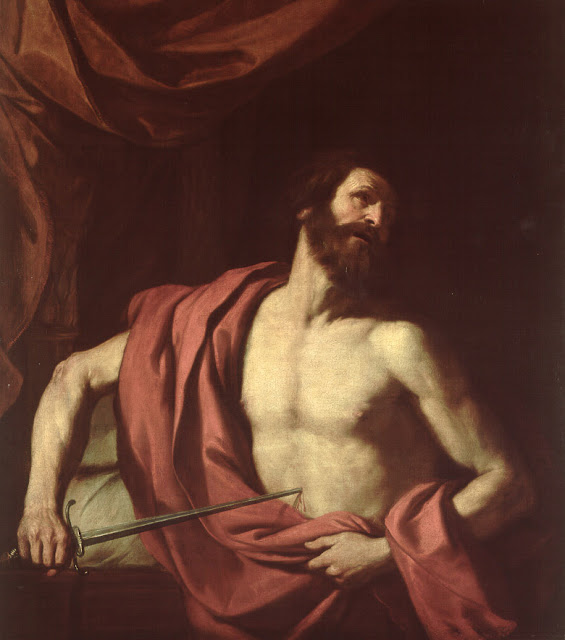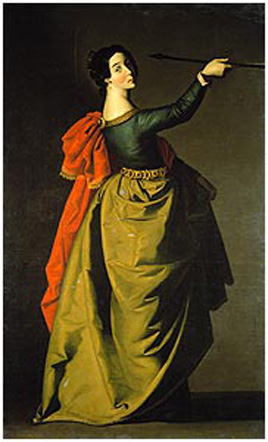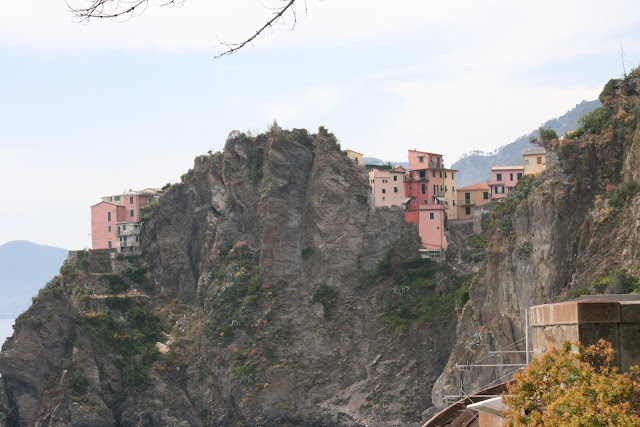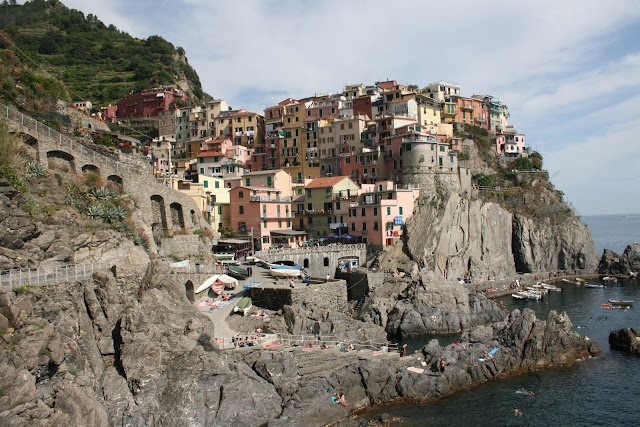I have been on holiday on the Italian Riviera and, all week, I have been trying to share some of my experiences in these blogs. Mostly, as I confessed, I planned to have a lazy relaxing time lying on the beach and indulging in the wonderful Italian cuisine but you can’t lie around all the time when there is so much of interest around you. Here are some of the places I visited just along the coast from my base in the little seaside town of Santa Margherita Ligure. The photograph above was taken from the ferry that took me on the 15 minutes journey from what now seemed like home. It was my first site of the little town of Rapallo.
It, like Santa Margherita and Portofino, was “discovered” by Northern Europeans and North Americans during the early 20th Century when it was declared “smart.” It isn’t difficult to see why when you walk along its wide, palm tree lined promenade. For those of us who live on the South coast of England, the place is immediately recognisable as an exotic version of our own seaside resorts but with much better weather and food.
Like my home town of Lewes, it too has its own Medieval castle and the odd cannon or two – it was so like home and yet totally different.
I wasn’t going to spend long here because the main purpose of the trip was to have a lingering if wind-swept lunch by the sea. I told you this was meant to be a lazy holiday.
Rapallo was known to me from University days as the town where the Modernist American poet Ezra Pound (1885-1972) lived out the second half of his life writing great but complex poetry but also, sadly, ruining his reputation and maybe his life and offending posterity with his enthusiastic defence of Mussolini’s fascism and with his increasingly racist opinions.
I engage with a lot of his work, just as I like the music of that other unpleasant genius, Richard Wagner and as I’m a bit of a culture nerd, I hoped to find the house where he lived. In my poet-obsessive way, I had been asking people ever since I arrived in Italy if they knew about his time in Rapallo but I always drew blank expressions and shrugs. No body, it seemed, had even heard of him – not even the woman in Rapallo’s largest bookshop. Maybe he is forgotten here, perhaps people want to forget him or more probably, I didn’t search deeply enough. The lunch was excellent though on that windy terrace by the sea and possibly, if I could only just let go, I knew enough about Ezra Pound already. He had a top floor apartment on the seafront somewhere behind the palm trees so maybe that was good enough to imagine him here the next time I dig into his infamous (because ferociously difficult to read) Cantos. Certainly here in the restaurant no one was talking about Modernist poetry.
After lunch, Rapallo seemed to fall asleep but I took the opportunity to look around idly gazing at those top floor apartment balconies whilst telling myself to leave all this Ezra Pound stuff alone.
There was enough to see here in its own right and when I left the main streets, I was free to imagine this place at any time in the last few hundred years.
I’m sure that the town would have livened up again later but for my short visit, thanks for this Rapallo, the town gave itself to me in siesta time and allowed me to imagine what it would have been like, sorry to go on, in Ezra Pound’s day.
After that it was time to head back to Santa Margherita Ligure for a late afternoon swim in the sea. It was often difficult summoning up the energy to leave my holiday home base but on another day I decided to visit the region’s major city, the historic capital of Liguria, Genoa, once the biggest port in Europe. It was easy enough to get there on the regular train service from Santa Margherita’s very efficient flower bedecked railway station.
I wasn’t sure what to expect after a friendly Genoan waiter that I met in Bologna once told me that I should avoid the dark alleyways of his home town, the callugi, or I would encounter prostitutes and, even worse, robbers, who would say, in that waiter’s own memorable phrase: “your money or your death.”
I wasn’t that worried when I arrived in Genoa because on a sunny day it looked magnificent against the Italian blue sky. Anyway, you don’t need to go to Genoa to find prostitutes or robbers, you can find them in Harrods.
It is a mini-Versailles, with even its own Hall of Mirrors but everything is on a smaller scale and, in all honesty, is more charming because it has very obviously seen better days and is in need of a bit of Genoan love and care.
I had already eaten too many great Italian meals on my trip to get full enjoyment out of the Hall of Mirrors but at least it acted as a oft-repeated reminder that there is a consequence to over-eating.
After the Royal Palace, I walked to the pedestrianised Via Garibaldi area where I encountered neither prostitue nor robber. I was looking for a group of palaces that have been turned into a co-joined set of art galleries known collectively as the Musei di Strada Nuova. The photograph below was taken from one of its terraces and you can see the two main buildings, the Palazzo Rosso (the Red Palace) and the Palazzo Bianco (the White Palace) – no prizes for spotting which is which.
There are also a number of works by the Genoan master Valerio Castello whom I first discovered on this holiday when I saw one of his paintings in the basilica in Santa Margherita. He and many of the other unfamiliar, to me anyway, Italian Baroque painters here in the museum were new to me but I am gradually being seduced by their particular taste for violent death and high drama. Here are some of the most memorable of them:
The picture and the painter who stays with me longest though, sorry another gloomy one, is Saint Ursula by the Spanish artist Francesco Zurbaran (1598-1664) whose work I’ve seen in books but never in the flesh as it were. This strange mix of realism and fantasy is distractingly modern, subtly surealistic, if that is possible and definitely very weird as the unfortunate saint, a lady of fashion obviously, raises the weapon of her distruction towards her head as if in an act of suicide. I might have to plan a trip to Spain to see more of this man’s work.
My final trip away from Santa Margherita Ligure was to a stretch of coastland called Cinque Terre, so beautiful and remarkable that it was made a Unesco World Heritage Site in 1997 and a National Park in 1999. Some say it has the most beautiful views in Europe so as it was just about an hour away along the coast, I thought it would be churlish not to go and take a look.
It came as no surprize that this area has won so many accolades, Cinque Terre is unique. Five little villages, the cinque in Cinque Terre, were built on these remote and inaccessible rocky cliff tops in the Middle Ages when the Mediterranean Sea was a dangerous place. Liguria was part of the Genoan Empire and if it wasn’t winning in the hurly-burley of rival Italian empires, it was losing and, either way, these waters were battle fields. Humans settled here, safe in their hideaways, many centuries before the current medieval buildings were constructed painfully I suspect on terraces hand-cut from the bare rockface. The villagers were secure but life was tough.
The villagers of Monterosso, Vernazza, Corniglia, Manarola and Riomaggiore created a viable living by terracing the rock for agriculture relying on the cliffs to defend them from the bad guys whilst they cultivated vines, vegetables, olives and lemons.
I took the train, life is easier these days I know but spare a thought for the workers who built the railway line here in the 19th. Century. I journeyed to the furthest village, Riomaggiore with a plan to make my way back to the nearest one, Monterosso at first on foot and then by boat. It was an inspirational day.
One of my first surprizes, rather mundanely, was that life could be so, well, ordinary up in these wonderful villages even though the phrase “sea views” is an understatement.
Life goes on wherever you are and the washing still needs to be done as does the shopping…..
…even though cars are banned and there are often a lot of steps between your apartment and the local shops.
The absence of cars might be inconvenient for the residents but it gives the place its mystique for visitors tired of city life and the noise of traffic. I know there is a car in that photograph but as with all rules there are also exceptions.
Before the trains, everything was transported by sea in and out of the little harbour at the bottom of Riomaggiore’s steep descent.
You don’t need to see the sea to pick up the nautical flavour of this atmospheric row of harbour side houses.
I’m not taking a boat from here though because the first part of the journey will be on foot along the so-called Via d’Amore
It is a sensational footpath with, yes, amazing views, especially, in my case, if you don’t look down too much.
It is goodbye to Riomaggiore, I’m on my way to the next village, Manarola but first there is a walk along the cliff tops.
Luckily this is Italy and you never have to go very far before finding a restaurant or a bar and on this walk you can even find a Bar d’Amore.
A little further on a nice Italian man will even play you a love song on his guitar. This is, after all the Via d’Amore.
Manarola is every bit as beautiful as Riomaggiore but it might have the edge in no nonsense Ligurian
practicality – I particularly liked the boats parked like cars outside their owners’ houses. I admired the waitress too in one of the restaurants who looked at her watch when I ordered tea and told me that that was fine, it was five to four in the afternoon – English tea time.
The people of Cinque Terre are practical because they have to be, things can be difficult when you live on a cliff and last winter there were major floods and landfalls around here so us visitors are often warned of the dangers by rather frightening signs.
This one was for swimmers in flip-flops and swimsuits making there way down some particularly vertiginous metal stairs.
The climb down was worth it for the cool sea breeze and the crystalline clear seawater.
Even in a tough maritime environment, Italians make sure that the sea is also their plaything.
I clambered down the rocks in a different direction on my way to the unadorned gap in the rocks where the ferry boat, I was told, would arrive in a few minutes.
I waited in patient disbelief….
…but sure enough, on schedule the ferry for Monterosso arrived to take me on the next stage of my journey.
Manarola looked very handsome from the sea – it was the best way to fully appreciate the reality of its location.
I was on my way to the third of the villages, Corniglia, but is land-locked so I could only watch it from the boat. Yet again, the view from the sea illustrated the story of these isolated communities surrounded by their terraced farms.
Next stop Vernazza….
…where everyone looked like they would spend the day swimming or at least walking round the village in their swimming costumes…
…but I had my eye on that precariously placed restaurant built, incredibly, on the side of the rock. I didn’t stop though because the boat was off again and it was time to go to the last village, Monterosso, the largest of the five where I would disembark to catch my train home.
I needn’t have rushed, in these parts, no body was in a hurry and it was very tempting to find a sun bed by the sea on the Cinque Terre’s only traditional tourist beach. After the other villages, it looked rather tame not to be swimming in rocky lagoons.
If all that walking and travelling that sounds too leisurely then here’s something a bit more arduous. You remember all that stuff about Ezra Pound in Rapallo, well here’s the man himself. No body does it quite like him so be patient with his very eccentric accent, it is worth the effort, believe me. If you have given up on Modernist poetry, and please don’t, then before that here’s Paganini’s “Cannone” violin being played on one of its rare outing from the Genoa Museum…forgive the news reporter, if you can, for talking over the great violin whenever it’s played.


























































